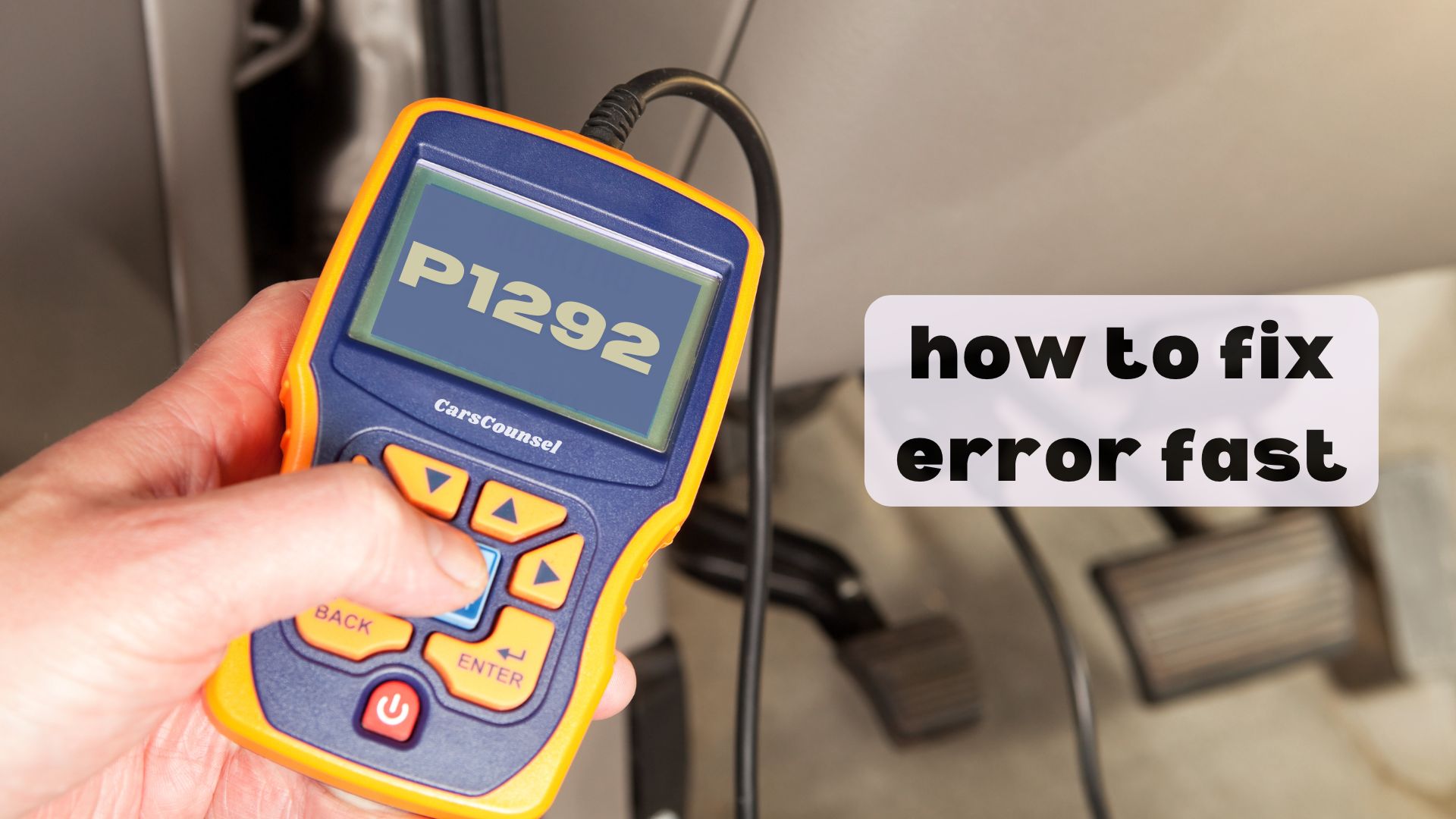Are you wondering why your compressed natural gas (CNG) vehicle is struggling to perform? You’ve noticed the Check Engine Light is on, and you’re concerned about the impact on fuel efficiency. The P1292 code is pointing to a critical issue: the CNG pressure sensor signal is too high. This could be due to a faulty sensor, clogged filters, or malfunctioning pressure regulators. As you investigate the possible causes, you’ll want to dig deeper to uncover the root problem and prevent further damage to your CNG system.

Quick Navigation
Key Takeaways
- The P1292 code signals a critical issue with the compressed natural gas (CNG) fuel system, affecting fuel efficiency and overall vehicle performance.
- A faulty CNG pressure sensor or sensor failure can send incorrect signals, triggering the code, and leading to faulty readings and potential fuel system problems.
- The code can also be caused by clogged fuel filters, malfunctioning fuel pressure regulators, or wiring issues, which must be inspected and addressed.
- Symptoms of the P1292 code include the Check Engine Light, reduced engine performance, rough idling, decreased fuel economy, and engine stalling or misfires.
- To fix the P1292 code, diagnose the problem using a scan tool, inspect and replace faulty components, and repair any CNG fuel system leaks.
Code P1292 Description
The P1292 diagnostic trouble code (DTC) signals a critical issue with your vehicle’s compressed natural gas (CNG) fuel system.
This code is specific to vehicles that use CNG as a fuel source. The CNG pressure sensor signal is too high, indicating a problem with the sensor or the fuel system.
This can affect fuel efficiency and overall vehicle performance. The sensor is vital for monitoring CNG pressure in the fuel system, and an incorrect signal can lead to issues with engine performance, emissions, and fuel efficiency.
It’s essential to address this code promptly to prevent further damage to your CNG system.
Common Causes of P1292
As you investigate the P1292 code, it’s essential to identify the root cause of the issue.
A faulty CNG pressure sensor can send incorrect signals, triggering the code. Sensor failure can lead to faulty readings, which may indicate a problem with the CNG fuel system.
Other common causes include clogged fuel filters, malfunctioning fuel pressure regulators, and CNG fuel system leaks. Wiring issues can also trigger the P1292 code.
It’s vital to inspect each component and rule out potential causes to determine the correct solution. By doing so, you’ll be able to address the issue effectively and get your vehicle running smoothly again.
Symptoms of P1292
When your vehicle’s engine control module detects an issue with the CNG fuel system, it triggers the P1292 code, which is often accompanied by several noticeable symptoms. You may notice a decrease in fuel economy and engine performance due to the incorrect fuel mixture caused by the high CNG pressure signal.
| Symptoms | Description | Impact on Vehicle |
|---|---|---|
| Check Engine Light | Illuminates on the dashboard | Alerts you to the issue |
| Reduced Engine Performance | Decreased power and acceleration | Affects overall driving experience |
| Rough Idling | Erratic or inconsistent engine idle | Impacts fuel economy and emissions |
These symptoms can lead to decreased engine performance, reduced fuel economy, and potentially even engine stalling or misfires if left unaddressed.
How to Fix P1292
Now that you’re aware of the symptoms associated with the P1292 code, it’s time to take action and fix the issue.
To restore your vehicle’s fuel efficiency and performance, start by diagnosing the problem using a scan tool.
Diagnose the problem using a scan tool to uncover the root cause of the P1292 code issue.
Inspect the CNG pressure sensor, fuel filter, fuel pressure regulator, and fuel system for any issues.
Replace the faulty components, such as the CNG pressure sensor or fuel filter, to guarantee accurate pressure readings and proper fuel flow.
Repair any CNG fuel system leaks to prevent pressure loss and certify proper fuel delivery.
Diagnosing the Issue
Your vehicle’s onboard diagnostics system has triggered the P1292 code, indicating a high CNG pressure sensor signal.
To diagnose the issue, start by conducting a thorough CNG system inspection to identify potential problems.
Check the fuel filter for clogs or restrictions and inspect the fuel pressure regulator for proper operation.
Perform fuel system testing to determine if there are any leaks or blockages in the system.
Use a diagnostic scan tool to retrieve trouble codes and monitor the CNG pressure sensor signal in real-time.
This will help you pinpoint the root cause of the issue and guide your repair efforts.
Replacing the CNG Pressure Sensor
One faulty CNG pressure sensor can wreak havoc on your vehicle’s fuel system, so replacing it is a key step in resolving the P1292 code. To guarantee precise pressure readings, you’ll need to replace the sensor with a new one. Before installing the new sensor, make sure to calibrate it according to the manufacturer’s instructions. Proper sensor calibration is essential for peak fuel efficiency and to prevent future issues.
| Step | Description |
|---|---|
| 1 | Purchase a new CNG pressure sensor compatible with your vehicle’s make and model. |
| 2 | Disconnect the electrical connector and remove the faulty sensor from the fuel system. |
| 3 | Install the new sensor, verifying it’s securely fastened and properly connected. |
| 4 | Calibrate the new sensor according to the manufacturer’s instructions. |
| 5 | Reconnect the electrical connector and test the sensor to guarantee precise pressure readings. |
Checking and Replacing the Fuel Filter
A clogged fuel filter can cause significant pressure increases in the CNG fuel system, leading to the P1292 code.
You’ll need to inspect the fuel filter for clogs or restrictions, which can be done as part of regular fuel system maintenance.
Cleaning or replacing the filter will guarantee proper fuel flow and prevent pressure buildup.
Make sure to follow the manufacturer’s guidelines for CNG filter cleaning and replacement to avoid damaging the fuel system.
A clean or new fuel filter can resolve the P1292 code and get your vehicle running smoothly again.
Testing and Replacing the Fuel Pressure Regulator
The fuel pressure regulator plays a critical role in maintaining the ideal fuel pressure in the CNG fuel system, and its malfunction can trigger the P1292 code.
As you test the fuel pressure regulator, look for signs of wear or damage. Check the regulator’s electrical connections and fuel lines for any blockages or leaks.
Use a pressure gauge to verify if the regulator is maintaining the correct pressure. If you notice pressure fluctuations, it’s likely the regulator is faulty.
Replace the fuel pressure regulator with a new one to guarantee consistent fuel pressure and resolve the P1292 code.
Repairing CNG Fuel System Leaks
After verifying the fuel pressure regulator is functioning correctly, you’ll want to inspect the CNG fuel system for any signs of leaks.
Start by performing a CNG system inspection, checking all connections, hoses, and fittings for signs of damage or wear.
Inspect the CNG system, scrutinizing connections, hoses, and fittings for signs of damage, wear, or potential failure points.
Utilize leak detection tools, such as soap solution or ultrasonic detectors, to identify any leaks. Pay particular attention to high-pressure areas, like the fuel tank and pressure regulator.
If you find a leak, make the necessary repairs to guarantee the system is tight and functional. This will help prevent further pressure loss and guarantee accurate CNG pressure sensor readings.
Cost to Fix P1292 and Additional Information
Fixing a P1292 code can be costly, but the exact expense depends on the root cause of the issue and the parts and labor required for the repair.
You’ll need to weigh the cost of replacement parts, labor hours, and any additional repairs necessary to get your vehicle running smoothly again.
- Replacing a CNG pressure sensor: $100-$200
- Replacing a fuel filter: $50-$100
- Repairing or replacing a fuel pressure regulator: $150-$300
Keep in mind that these are rough estimates, and your total fuel cost and repair estimates may vary depending on your vehicle’s make and model, as well as the complexity of the repair.
It’s always a good idea to ponder a professional mechanic or your vehicle’s repair manual for specific guidance.
More OBD-II Codes
| P1293 | P1294 | P1226 | P1209 |
| P1210 | P1204 | P1202 | P1203 |
| P1198 | P1146 | P1145 | P1144 |
| P1143 | P1142 | P1140 | P1139 |
| P1141 | P1138 | P1137 | P1222 |
| P1221 | P1214 | P1213 | P1212 |
Frequently Asked Questions
Can I Drive My Vehicle With a P1292 Code?
You shouldn’t drive your vehicle with a P1292 code, as it affects fuel efficiency and vehicle performance, causing reduced power, rough idling, and increased emissions, which can lead to further damage and decreased fuel efficiency.
Will a P1292 Code Cause Long-Term Engine Damage?
You’re probably wondering if driving with a faulty CNG pressure sensor will turn your engine into a ticking time bomb – the good news is that it’s unlikely to cause catastrophic damage, but it may affect sensor calibration and fuel efficiency, leading to decreased performance and higher emissions.
Can I Reset the Code Without Fixing the Issue?
You shouldn’t reset the code without fixing the issue, as it may lead to improper sensor calibration and fuel injector performance, causing further problems and potentially leading to more severe consequences if left unaddressed.
Is the P1292 Code Specific to Certain Vehicle Models?
You’ll find that vehicle compatibility plays a crucial role in determining which models are affected by the P1292 code, as it’s typically tied to manufacturer specifications and only applicable to vehicles designed to run on compressed natural gas.
Can a Faulty Oxygen Sensor Trigger a P1292 Code?
You’re wondering if a faulty oxygen sensor can trigger a P1292 code. The answer is no, as an oxygen sensor malfunction doesn’t affect fuel pressure, so it won’t impact fuel efficiency or trigger this specific code.
Conclusion
So, you thought switching to compressed natural gas would save you money and reduce your carbon footprint. But now, your vehicle’s CNG system is malfunctioning, and you’re left dealing with the P1292 code. The irony isn’t lost on you – a system meant to be eco-friendly and cost-effective is now draining your wallet and causing frustration. Don’t let the problem linger; address it promptly to avoid further damage and get back to enjoying the benefits of CNG.

